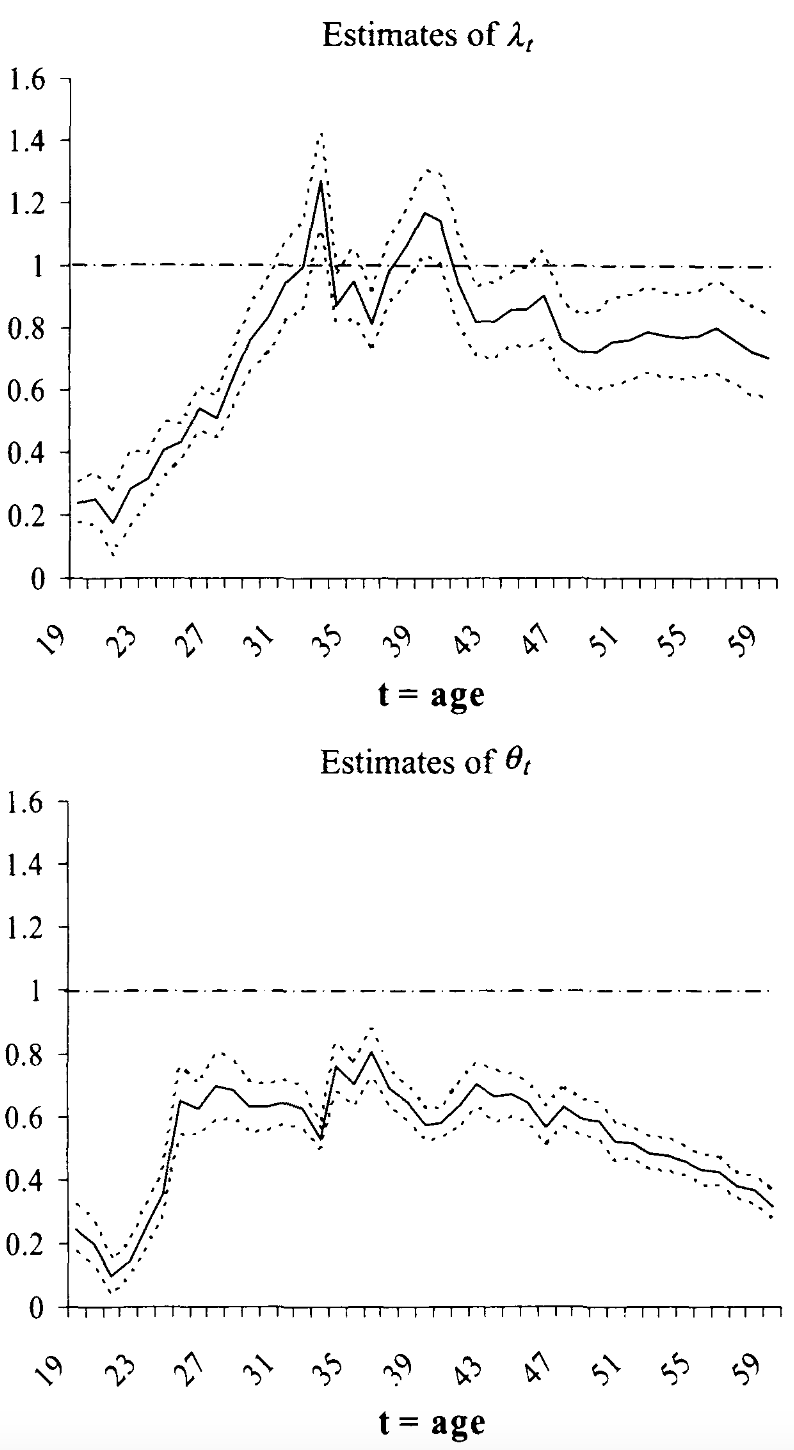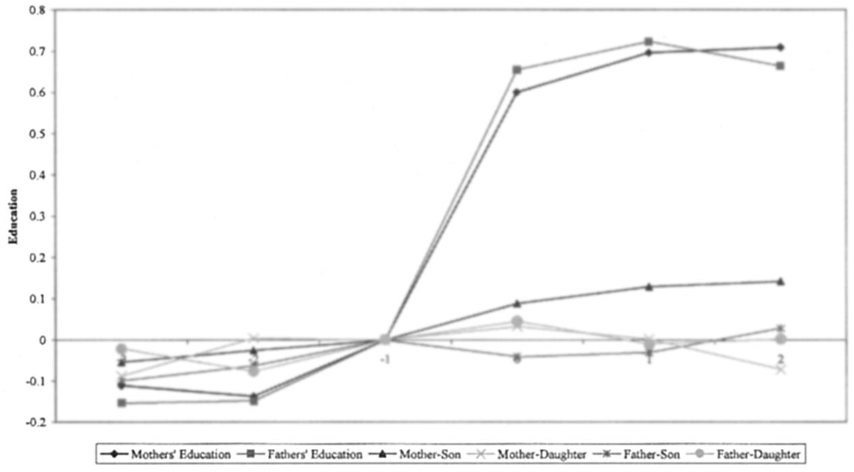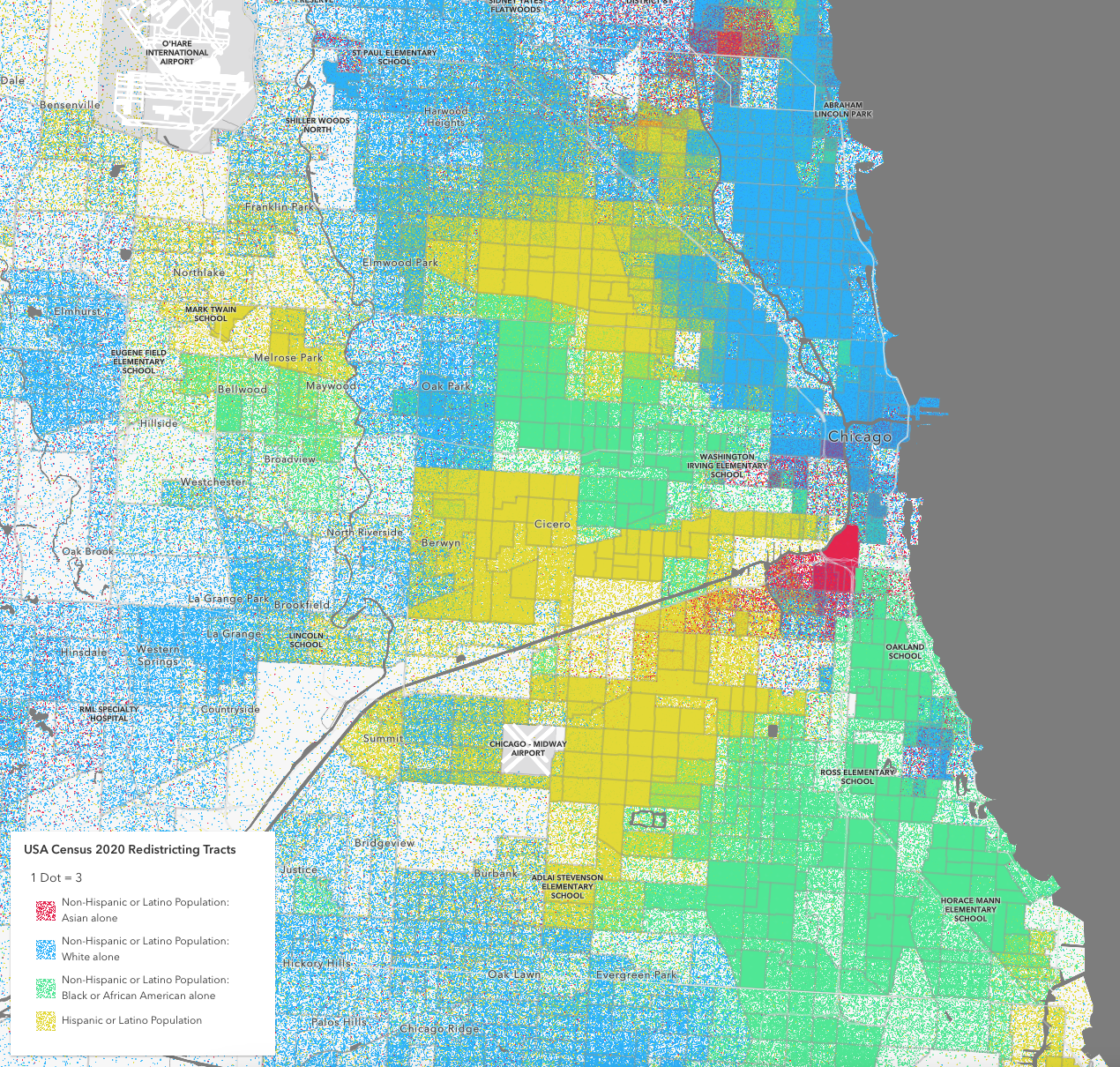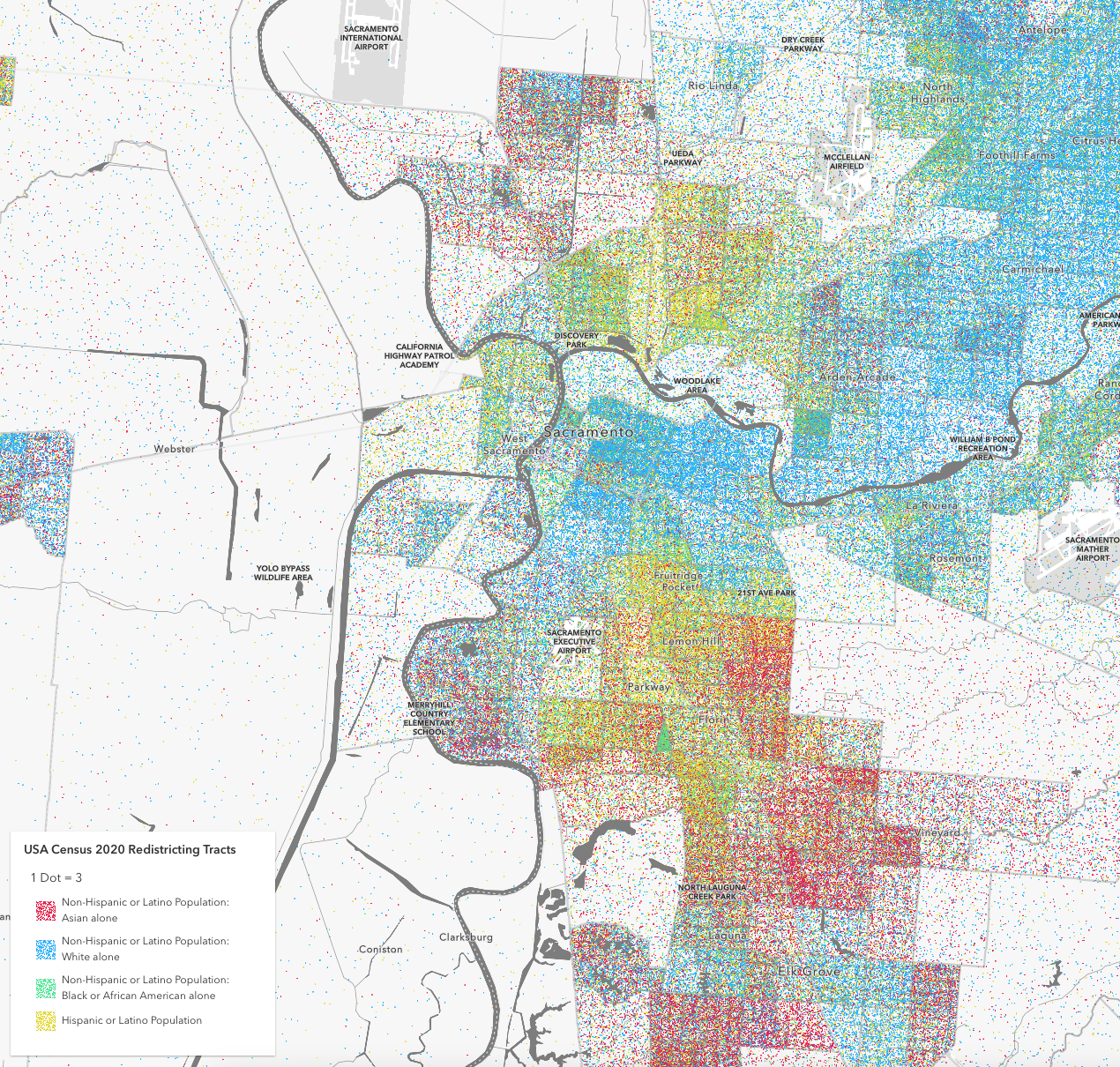| Elasticity | Correlation | Elasticity | Correlation | |
|---|---|---|---|---|
| Denmark | 0.071 | 0.089 | 0.034 | 0.045 |
| Finland | 0.173 | 0.157 | 0.080 | 0.074 |
| Norway | 0.155 | 0.138 | 0.114 | 0.084 |
| Sweden | 0.258 | 0.141 | 0.191 | 0.102 |
| UK | 0.306 | 0.198 | 0.331 | 0.141 |
| US | 0.517 | 0.357 | 0.283 | 0.160 |
Source: Table 2
KAT.TAL.322 Advanced Course in Labour Economics
April 10, 2024
Do children “inherit” their outcomes from parents?
Budget constraint
Parent’s income \(y_{t - 1}\) allocated to consumption \(C_{t - 1}\) and investment into child \(I_{t - 1}\): \[y_{t - 1} = C_{t - 1} + I_{t - 1}\]
Investment technology
Investment \(I_{t - 1}\) and other determinants \(E_t\) produce child’s earnings \(y_t\): \[y_t = (1 + r)I_{t - 1} + E_t\]
Maximise intergenerational utility (Cobb-Douglas)
\[ \max_{I_{t - 1}, C_{t - 1}} \left(1 - \alpha\right) \log C_{t - 1} + \alpha \log y_t \]
The first-order condition for \(I_{t - 1}\) implies
\[ I_{t - 1} = \alpha y_{t - 1} - \frac{(1 - \alpha) E_t}{1 + r} \]
Plug it back to the investment technology equation:
\[ y_t = \alpha(1 + r) y_{t - 1} + \alpha E_t \]
If \(E_t \perp y_{t - 1}\) and \(Var(y_t) = Var(y_{t - 1}) \Rightarrow \text{Corr}(y_t, y_{t - 1}) = \alpha (1 + r)\)
Suppose \(E_t = e_t + u_t\), where \(e_t\) is endowment and \(u_t\) is randomness.
Endowment is passed down the generations: \(e_t = \lambda e_{t - 1} + v_t\)
\[ y_t = \alpha(1 + r) y_{t - 1} + \alpha e_t + \alpha u_t \]
Assuming \(y_t\) is stationary,
\[\text{Corr}(y_t, y_{t - 1}) = \delta \alpha(1 + r) + (1 - \delta) \frac{\alpha(1 + r) + \lambda}{1 + \alpha(1 + r) \lambda}\]
where \(\delta = \frac{\alpha^2 \sigma_u^2}{(1 - \alpha^2 (1 + r)^2)\sigma_y^2}\).
Even the simple model highlights important channels:
Importance \(\alpha\) of child’s future earnings on parent’s utility
Return to investments \(r\) (e.g., returns to education)
Strength of intergenerational transmission of endowments \(\lambda\)
Magnitude of market luck relative to endowment luck \(\delta\)
Notice \(\uparrow r\) (a measure of income inequality) implies higher correlation between generations, or lower mobility.
This relationship is captured by the Great Gatsby curve.
Source: Figure 1 in Corak (2013)
Ignores transfer of assets (revisited Becker and Tomes 1986)
Single parent \(\Rightarrow\) ignores assortative mating
Single child \(\Rightarrow\) ignores intrahousehold allocation
Arbitrary functional forms
Simple regression (ignoring process on endowments)
\[ y_t = \beta y_{t - 1} + \varepsilon \]
where \(y_t\) and \(y_{t - 1}\) are log earnings and \(\beta\) is IGE elasticity.
Challenges
Source: Table 2 in Solon (1992)
Using father’s education as an instrument for father’s single-year earnings

Source: Table 4 in Mazumder (2005)
\[ \begin{align} y^\text{parent}_a &= \mu_a y^\text{parent} + v \\ y^\text{child}_a &= \lambda_a y^\text{child} + u \end{align} \]
In this case, IGE elasticity estimator \(\hat{\beta}\) is inconsistent:
\[ \text{plim}~\hat{\beta} = \beta \lambda_a \theta_a \]
where \(\theta_a = \frac{\mu_a \text{Var}(y^\text{parent})}{\mu_a^2 \text{Var}(y^\text{parent}) + \text{Var}(v)}\)

|
Men
|
Women
|
|||
|---|---|---|---|---|
| Elasticity | Correlation | Elasticity | Correlation | |
| Denmark | 0.071 | 0.089 | 0.034 | 0.045 |
| Finland | 0.173 | 0.157 | 0.080 | 0.074 |
| Norway | 0.155 | 0.138 | 0.114 | 0.084 |
| Sweden | 0.258 | 0.141 | 0.191 | 0.102 |
| UK | 0.306 | 0.198 | 0.331 | 0.141 |
| US | 0.517 | 0.357 | 0.283 | 0.160 |
Source: Table 2
Black and Devereux (2011): recent studies focus on causal mechanisms
What is the “optimal” amount of intergenerational mobility?
High \(H\) parent invest more in child’s \(H \Rightarrow\) high IG correlation
Type of policy depends on channel:
School reform in Finland 1972-77: selective \(\rightarrow\) comprehensive
Source: Figure 1
Standard IGE elasticity regression
\[ \log(y_\text{son}) = a + b_{jt} \log(y_\text{father}) + e \qquad(1)\]
Effect of reform on IGE elasticity
\[ b_{jt} = b_0 + \delta R_{jt} + \Omega D_j + \Psi D_t \qquad(2)\]
where \(R_{jt}\) indicates if reform in municipality \(j\) affected cohort \(t\).

| (1) | (2) | (3) | (4) | |
|---|---|---|---|---|
| Father’s earnings | 0.277 | 0.297 | 0.298 | 0.296 |
| (0.014) | (0.011) | (0.010) | (0.014) | |
| Reform | −0.063 | −0.019 | ||
| (0.012) | (0.021) | |||
| Father’s earnings \(\times\) reform | −0.055 | −0.069 | −0.066 | |
| (0.009) | (0.022) | (0.031) | ||
| Obs. | 20 824 | 20 824 | 20 824 | 20 824 |
| \(R^2\) | 0.05 | 0.05 | 0.05 | 0.06 |
| Cohort FE | Yes | Yes | ||
| Father’s earnings \(\times\) cohort FE | Yes | Yes | ||
| Region FE | Yes | Yes | ||
| Father’s earnings \(\times\) region FE | Yes | Yes | ||
| Cohort FE \(\times\) region FE | Yes | |||
| Region-specific trend | Yes |
Source: Table 3
Do educational reforms have spillover effects on children?
School reform in Norway in 1960-71: compulsory edu 7 \(\rightarrow\) 9 years
IV approach
\[ \begin{align} E &= \beta E^p + \gamma X + \gamma_p X^p + \epsilon \\ E^p &= \alpha {REFORM}^p + \delta X + \delta_p X^p + v \end{align} \]

Limited IG spillover of school reform at the bottom
Expansion of Finnish university system in 1955-75
Source: Figure 1
University access measures based on distance from municipality of birth
Event study and IV approach
\[ \begin{align} E^c_{ijmc} &= \beta_0 + \beta_1 E^p_{ijmc} + \beta_2 X_{ijmc} + \theta_m + \mu_c + \varepsilon_{ijmc} \\ E^p_{ijmc} &= \alpha_0 + \alpha_1 {UniAccess}_{ijmc} + \alpha_2 X_{ijmc} + \gamma_m + \delta_c + \vartheta_{ijmc} \end{align} \]
\(i\) - child, \(j\) - parent, \(m\) - parent birth municipality, \(c\) - parent birth cohort.
| Child's years of education | ||||
|---|---|---|---|---|
| Full sample | Grandparent nonmissing | |||
| OLS | IV | |||
| (1) | (2) | (3) | (4) | |
| Mother's years of education | 0.345*** | 0.522*** | 0.540*** | 0.697*** |
| (0.004) | (0.133) | (0.143) | (0.120) | |
| F-stat (IV) | 4.1 | 14.2 | 21.3 | |
| Obs. | 1 239 331 | 1 239 331 | 1 239 331 | 628 230 |
| Father's years of education | 0.305*** | 0.400** | 0.535*** | 0.612*** |
| (0.003) | (0.161) | (0.171) | (0.143) | |
| F-stat (IV) | 3.7 | 12.7 | 19.6 | |
| Obs. | 1 195 008 | 1 195 008 | 1 195 008 | 710 677 |
| Additional controls | Yes | Yes | ||
Source: Table 7
Strong positive spillover from parent’s to child’s education
Suggestive evidence that
assortative mating between parents can account for >50% of effects
higher parental income could also contribute to the results
IG transmission present in pre-uni school outcomes
Important for mobility discussion: complier parents mainly from low-educated and low-income families
IGE mobility varies geographically (Chetty et al. 2014)
Source: Figure II
Geographic variation in IGE mobility may stem from:
selection into neighbourhoods
causal effect of neighbourhoods
Do children moving to higher mobility area have better outcomes?
Endogenous moving \(\Rightarrow\) exploit timing of move
Identifying assumption
Selection into moving to a better area does not vary with age
Source: Figure IV
What makes neighbourhoods generate good outcomes?
Together explain 58% of variation in CZ causal effect
How much of IGE elasticity driven by nature vs nurture?
Extension of standard model:
genetic transmission and assortative mating
skill transmission: genetic factors, parental investments, family environment and idiosyncratic events
Minnesota Twin Family Study (income, skills, genotypes + parents)
Source: Table 1
Source: Table 3
Typical regression of parent-child pairs
\[ \ln y^\text{child} = \beta_{-1} \ln y^\text{parent} + \varepsilon \]
Similar estimation across \(k\) generations
\[ \ln y^\text{child} = \beta_{-k} \ln y^{k \text{ ancestor}} + \vartheta \]
Iterated regression fallacy: \(\beta_{-k} \neq \left(\beta_{-1}\right)^k\)
Source: Figure 2
Possible explanations of iterated regression fallacy:
Latent endowment
\[ \begin{align} y_{it} &= \rho e_{it} + u_{it} \\ e_{it} &= \lambda e_{it - 1} + v_{it} \\ \Rightarrow \Delta &= (\rho^2 - 1)\rho^2\lambda^2 \end{align} \]
Multiple endowments
\[ \begin{align} y_{it} &= \rho_1 e_{1it} + \rho_2 e_{2it} + u_{it} \\ e_{1it} &= \lambda_1 e_{1it - 1} + v_{1it} \\ e_{2it} &= \lambda_2 e_{2it - 1} + v_{2it} \\ \Rightarrow \Delta &= -\rho_1^2\rho_2^2\left(\lambda_1 - \lambda_2\right)^2 \end{align} \]
Grandparent effect
\[ e_{it} = \lambda_{-1}e_{it-1} + \lambda_{-2}e_{it-2} + v_{it} \]
Other explanations
Parental investments, bequests, etc.
Current individuals in Florence \(\leftrightarrow\) ancestors in 1427 based on surnames
Source: Table 3
Horizontal approach: Grandparent-grandchild \(\rightarrow\) cousin-cousin
blood relationships: intergenerational processes
in-law relationships: assortative processes
Swedish registry: “up to 141 distinct kinship moments”
Source: https://xkcd.com/2040
\[ \begin{align} y_t &= \beta \tilde{y}_{t - 1} + \gamma \tilde{z}_{t - 1} + e_t + v_t + x_t + u_t \\ \tilde{y}_{t - 1} &= \alpha_y y_{t - 1}^m + \left(1 - \alpha_y\right) y_{t - 1}^f \\ \tilde{z}_{t - 1} &= \alpha_z z_{t - 1}^m + \left(1 - \alpha_z\right) z_{t - 1}^f \end{align} \]
\(\beta\) and \(\alpha_y\) measure direct transmission
\(\gamma\) and \(\alpha_z\) measure indirect transmission
\(u_t\) is white noise (market luck)
\(v_t\) is white noise in latent factor (endowment luck)
\(x_t\) is shared sibling component
\(e_t\) is latent sibling component
| \(\beta\) | \(\gamma\) | \(\alpha_y\) | \(\alpha_z\) | \(\sigma_y^2\) | \(\sigma_u^2\) | \(\sigma_z^2\) | \(\sigma_x^2\) | \(\sigma_e^2\) | |
|---|---|---|---|---|---|---|---|---|---|
| Men | 0.144 | 0.664 | 0.389 | 0.660 | 4.648 | 1.975 | 2.072 | 0.180 | 0.657 |
| Women | 0.129 | 0.566 | 0.018 | 0.775 | 4.465 | 2.333 | 1.559 | 0.244 | 0.712 |
Vast literature on intergenerational mobility
Improving access to education promotes mobility
Geographic variation in mobility; largely causal
Genetic endowment and assortative mating important components
Multigenerational mobility slower than predicted
Source: Table 2 in Gelber and Isen (2013)

